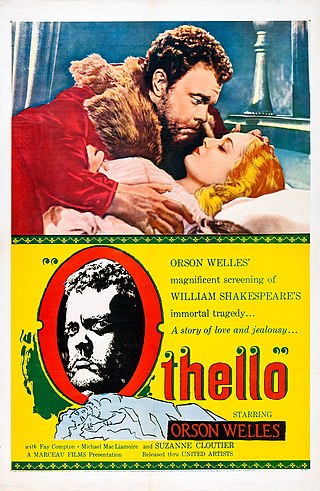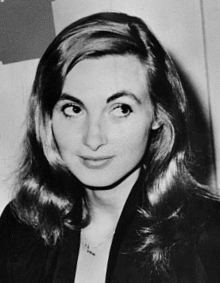
George Orson Welles was an American director, actor, writer, producer, and magician who is remembered for his innovative work in film, radio, and theatre. He is considered to be among the greatest and most influential filmmakers of all time.

F for Fake is a 1973 docudrama film co-written, directed by, and starring Orson Welles who worked on the film alongside François Reichenbach, Oja Kodar, and Gary Graver. Initially released in 1974, it focuses on Elmyr de Hory's recounting of his career as a professional art forger; de Hory's story serves as the backdrop for a meandering investigation of the natures of authorship and authenticity, as well as the basis of the value of art. Far from serving as a traditional documentary on de Hory, the film also incorporates Welles's companion Oja Kodar, hoax biographer Clifford Irving and Orson Welles as himself. F for Fake is sometimes considered an example of a film essay.
Oja Kodar is a Croatian actress, screenwriter and director known as Orson Welles's romantic partner during the later years of his life.

Othello is a 1951 tragedy directed and produced by Orson Welles, who also adapted the Shakespearean play and played the title role. Recipient of the Grand Prix du Festival International du Film at the 1952 Cannes Film Festival, the film was distributed by United Artists when it was released in the United States in 1955. Othello was filmed on location over a three-year period in Morocco, Venice, Tuscany and Rome as well as at the Scalera Studios in Rome.

Chimes at Midnight is a 1966 period comedy-drama film written, directed by, and starring Orson Welles. Its plot centers on William Shakespeare's recurring character Sir John Falstaff and his fatherly relationship with Prince Hal, who must choose loyalty to Falstaff or to his father, King Henry IV. The English-language film was an international co-production of Spain, France, and Switzerland.
Someone to Love is a 1987 comedy film directed by Henry Jaglom. It was Orson Welles' final live action film appearance, released two years after his death but produced before his voice-over in The Transformers: The Movie, his final film performance.
Hello Cinema is a 1995 Iranian film directed by Mohsen Makhmalbaf. It was screened in the Un Certain Regard section at the 1995 Cannes Film Festival. It was made for the celebration of the 100th anniversary of cinema. The year 1895 is considered the debut of the motion picture as an entertainment medium. The year 1895 was the year of the first film screenings by Auguste and Louis Lumière.

The Other Side of the Wind is a 2018 satirical drama film co-written, co-edited, and directed by Orson Welles, and posthumously released in 2018 after 48 years in development. The film stars John Huston, Bob Random, Peter Bogdanovich, Susan Strasberg, and Oja Kodar.

Gary Foss Graver was an American film director, editor, screenwriter and cinematographer. He was a prolific filmmaker, working in various roles on over 300 films, but is best known as Orson Welles' final cinematographer, working over a period of six years on Welles' epic film The Other Side of the Wind which was released in 2018, 48 years after it was started.
The Orson Welles Show was an unsold television talk show pilot directed by Orson Welles. It has never been broadcast or released in its entirety. Filming began in September 1978 and the project was completed around February 1979. It ran 74 minutes and was intended for a 90 minute commercial time slot.
The Dreamers is an unfinished film project directed and produced between 1980 and 1982 by Orson Welles. Adapted from Karen Blixen stories, Welles co-wrote a script with his companion Oja Kodar and filmed a few scenes but was unable to complete the film due to financing problems.
Don Quixote is an unfinished film project written, co-produced and directed by Orson Welles. Principal photography took place between 1957 and 1969. Test footage was filmed as early as 1955, second-unit photography was done as late as 1972, and Welles was working on the film intermittently until his death in 1985. The film was eventually edited by Jesús Franco and was released in 1992, to mixed reviews.
The Deep is an unfinished film directed by Orson Welles, based on Charles Williams' novel Dead Calm (1963), which was later adapted as an eponymous 1989 film. Welles produced and wrote The Deep, as well as played the role of Russ Brewer opposite Jeanne Moreau and Laurence Harvey.

The Merchant of Venice is a 1969 drama short film directed by Orson Welles based on William Shakespeare's play of the same name. While actually completed, it is frequently cited as an unfinished film, though better described as a partially lost film due to the loss of film elements.
Filming 'The Trial' is an unfinished making-of film by Orson Welles, made in 1981, which focuses on the production of his 1962 film The Trial.

Paola di Gerfalco, Contessa di Gerfalco, better known by her professional name Paola Mori, was an Italian actress and aristocrat, and the third and last wife of Orson Welles.
An Evening with Orson Welles is a series of six short films created in 1970 by Orson Welles, for the exclusive use of Sears, Roebuck & Co. Welles produced the recitations of popular stories for Sears's Avco Cartrivision machines, a pioneering home video system. Four of the films are regarded as lost; as of 2022, two of the films, The Golden Honeymoon and Two Wise Old Men: Socrates and Noah, are known to exist.

The Citizen Kane trailer is a four-minute, self-contained, "making of" promotional short film by Orson Welles and the Mercury Theatre, released in 1940 to promote the film Citizen Kane. Unlike other standard theatrical trailers of the era, it did not feature any footage of the actual film itself, but was a wholly original pseudo-documentary piece. It is considered by numerous film scholars such as Simon Callow, Joseph McBride and Jonathan Rosenbaum to be a standalone short film, rather than a conventional trailer, and to represent an important stage in developing Welles's directorial style.

Your Name Here is a 2015 feature-length docufiction from Canada written and directed by B. P. Paquette and featuring dozens of amateur actors. The film examines the art and craft of movie acting, and the desire for movie stardom.
Beatrice Giuditta Welles is an American former child actress, known for her roles in the film Chimes at Midnight (1966) and the documentary travelogue In the Land of Don Quixote (1964). The daughter of American filmmaker Orson Welles and Italian actress Paola Mori, she is a former model, radio and TV personality, founder of a cosmetics line and designer of handbags and jewelry.









